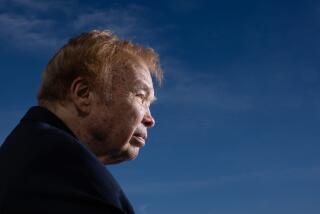Visionary with a sharp edge
If J.G. Ballard -- the visionary British novelist who died Sunday of prostate cancer at age 78 -- ends up being remembered, it will likely be as a science fiction writer who aspired to use genre as a vehicle for art. That’s true enough, in a certain small-bore manner, but it’s ultimately reductive, a way of categorizing Ballard that his entire career stood against.
A member of the New Wave science fiction movement of the 1960s, Ballard started out writing proto-environmental thrillers that highlighted the prescience of his imagination: “The Wind From Nowhere” posits a world-wide windstorm that becomes apocalyptic, while “The Drowned World” is about a planet swamped by risen seas.
It was really in the 1970s, however, that Ballard found his voice as a writer, focusing on the dangers of mechanization and socialization, the tension between the veneer of civilization and the animal brutality it sought to conceal. Novels such as “Crash” and “High-Rise” uncovered the orgiastic possibilities of violence years before the concept became common cultural currency; “Vermilion Sands” and “Running Wild” investigated a nightmare suburbia where chaos simmered beneath the landscaped surfaces of subdivisions and lawns.
It’s easy, from the perspective of the present, to minimize just how revolutionary all this was -- we now live, after all,s in Ballard’s world. Ballard, though, produced work that not only challenged his audiences but also actively provoked them, in some cases literally moving people to vandalism, as when he staged a 1970 exhibition of crashed cars at a London art gallery. This show, intended to illustrate the fetishization of machinery and violence, was a seminal moment for Ballard: It led to the publication of “Crash” in 1973, a novel about automobiles and violence, and the eroticism of car crashes (which was turned into a 1996 film by David Cronenberg).
“The marriage of reason and nightmare which has dominated the 20th century,” the author wrote in a 1974 introduction to the French edition of the novel, “has given birth to an ever more ambiguous world. Across the communications landscape move the specters of sinister technologies and the dreams that money can buy. Thermonuclear weapons systems and soft drink commercials coexist in an overlits realm ruled by advertising and pseudoevents, science and pornography. Over our lives preside the great twin leitmotifs of the 20th century -- sex and paranoia.”
Ballard is best known for his autobiographical novel “Empire of the Sun,” which described his boyhood experiences in a Japanese internment camp in Shanghai; it was filmed by Steven Spielberg in 1987. But for me -- as well as, I suspect, most Ballardites -- the signal text remains “The Atrocity Exhibition,” a book so strange it’s nearly impossible to describe. Collecting 15 “stories,” all of them so compressed and fragmentary as to render traditional concepts of narrative or character moot, it provoked its own kind of violent reaction: After the book was published in 1970, notes the 1990 RE/Search Publications edition, “Nelson Doubleday saw a copy and was so horrified he ordered the entire press run shredded.”
According to Ballard, the story that pushed Doubleday over the edge was a piece about Ronald Reagan, the title of which I can’t reproduce here. This same story was the subject of a 1968 British obscenity trial, after the Unicorn Bookshop in Brighton published it as a pamphlet; when asked by his attorney why it was not obscene, Ballard replied “that of course it was obscene, and intended to be so.” Needless to say, he did not appear as a witness in his own defense.That’s a funny moment, but it’s also deadly serious, suggesting the essence of Ballard’s aesthetic, his point- of- view. For him, obscenity was a matter of cultural obsession; it was not his work per se, but our fixation on the figure of Reagan that made the story fit the charge.
“The Atrocity Exhibition” is full of such revelations: The final story, “The Assassination of John Fitzgerald Kennedy Considered as a Downhill Motor Race” (after Alfred Jarry’s “The Crucifixion Considered as an Uphill Bicycle Race”), is as transgressive a piece of fiction as can be imagined, seven years after the death of the president.
“Oswald was the starter,” Ballard begins, then takes us through a schematic of the shooting, concluding, “Without doubt Oswald badly misfired. But one question still remains unanswered: who loaded the starting gun?”
Here, we see Ballard’s preoccupations come together: violence, spectacle and mass imagination, examined in a prose as flat and unaffected as an autopsy report.
“[I]n a totally sane society,” he once wrote, “madness is the only freedom” -- an idea that sits at the center of “The Atrocity Exhibition,” and, indeed, of his entire career.
[email protected] is book editor of The Times.
More to Read
Sign up for our Book Club newsletter
Get the latest news, events and more from the Los Angeles Times Book Club, and help us get L.A. reading and talking.
You may occasionally receive promotional content from the Los Angeles Times.









